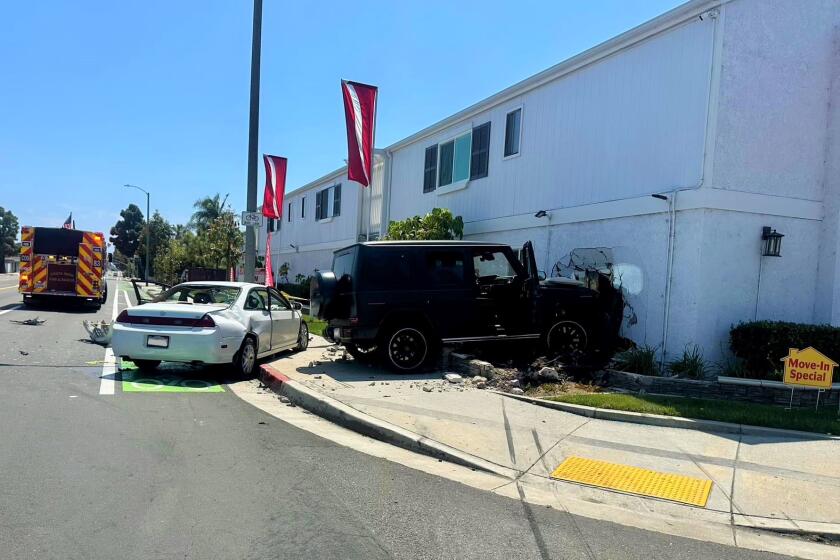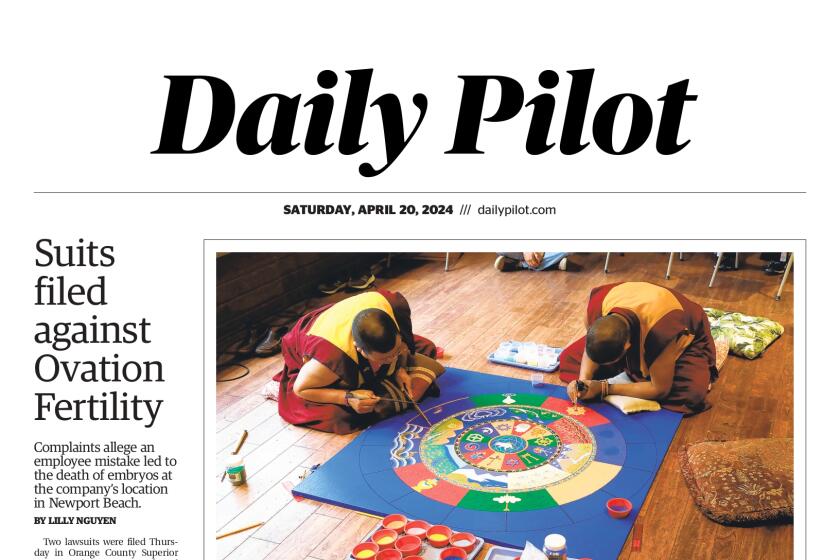A blast at Boeing
It was the first time the Otto family took a crack at making a water bottle rocket, and the youngest of the group was itching to get it to the launch site.
The Ottos and hundreds of other families spent their Saturday morning attaching fins and cones to 2-liter bottles and launching them into the sky for the seventh Rocket Launch event at Boeing’s facility in Huntington Beach.
Though it was his first time building a bottle rocket from scratch, Jake Otto, 6, is no stranger to the miniature space ships. The youngster from Pasadena has built Estes model rockets with his father.
“I want to build rockets that go to the moon, Mars, Jupiter and Uranus,” Jake said. “I’ve always dreamed of being a spaceman.”
The days leading up to the event were gloomy and wet, but Saturday was ideal for rocket launching, Boeing vice president of engineering and mission assurance Rick Baily said.
“A little bit of wind is actually good because it gets it drifting and gives [the rocket] a little more float,” he said.
The goal for participants was to launch their rockets as high as possible and keep them aloft the longest. Successful rockets had a parachute that deployed, slowly aiding the descent back to the lawn at Boeing. Some participants designed their parachutes so well that a few floated up and landed in surrounding trees.
The grand prize winner of the event gets a chance to see an actual rocket launch at Vandenberg Air Force Base. That honor went to Romeo Curry, with a winning time of 46 seconds. He was in the kindergarten through sixth-grade category.
“The secret to this event is the parachute design and the parachute deployment,” Baily said. “Every once in a while, you’ll see one that gets way up there, but if the parachute doesn’t come out, it comes down just as fast.”
Boeing puts on the event with the Discovery Science Center in Santa Ana, a nonprofit that focuses on educating children about science, math and technology. According to Science Center spokesman Dan Nasitka, the Rocket Launch started to tickle the curiosity of up-and-coming young engineers.
“Our technical team is going to retire in the next 10 years, so we need to replace them,” Baily said. “So we need to get these kids interested in math and science and get them on a path where they can be the engineers working on the great stuff that we do in the future.”
Not only did the children get a chance to launch their rockets, they were also able to talk to a man who rode in one.
Col. Walter Cunningham was an astronaut aboard Apollo 7, the first U.S. manned space flight. He enjoyed seeing the competition among the children and their interest in aeronautics.
“It’s a generational change,” said Cunningham, who built model planes when he was a child. “It’s nice to see people learning the first steps about propulsion and rockets. I’m really excited. My wife is out there; she brought a couple bottles with her because she wants to launch her own.”
There were three sets of rocket launches that morning, with three categories dividing participants — kindergarten through sixth grade, seventh through 12th and adults.
The first set of launches was dominated by 10-year-old Jack Byers, whose rocket stayed in the air for 40 seconds. The best rocket from the adult class was airborne for only eight seconds.
Jack has participated in all seven annual Rocket Launches. He had an idea of how he wanted to build his rocket this year but put it together only the night before the event.
“We come to Rocket Launch every year and we have a basic idea of what the rockets are supposed to be like,” he said. “This [rocket] was following that plan.”
Jack, whose father works for Boeing, said his goal is to be a scientist.
“It would definitely be a good thing for life,” he said. “But I definitely want to be some sort of scientist, and a rocket scientist could possibly work.”
All the latest on Orange County from Orange County.
Get our free TimesOC newsletter.
You may occasionally receive promotional content from the Daily Pilot.



